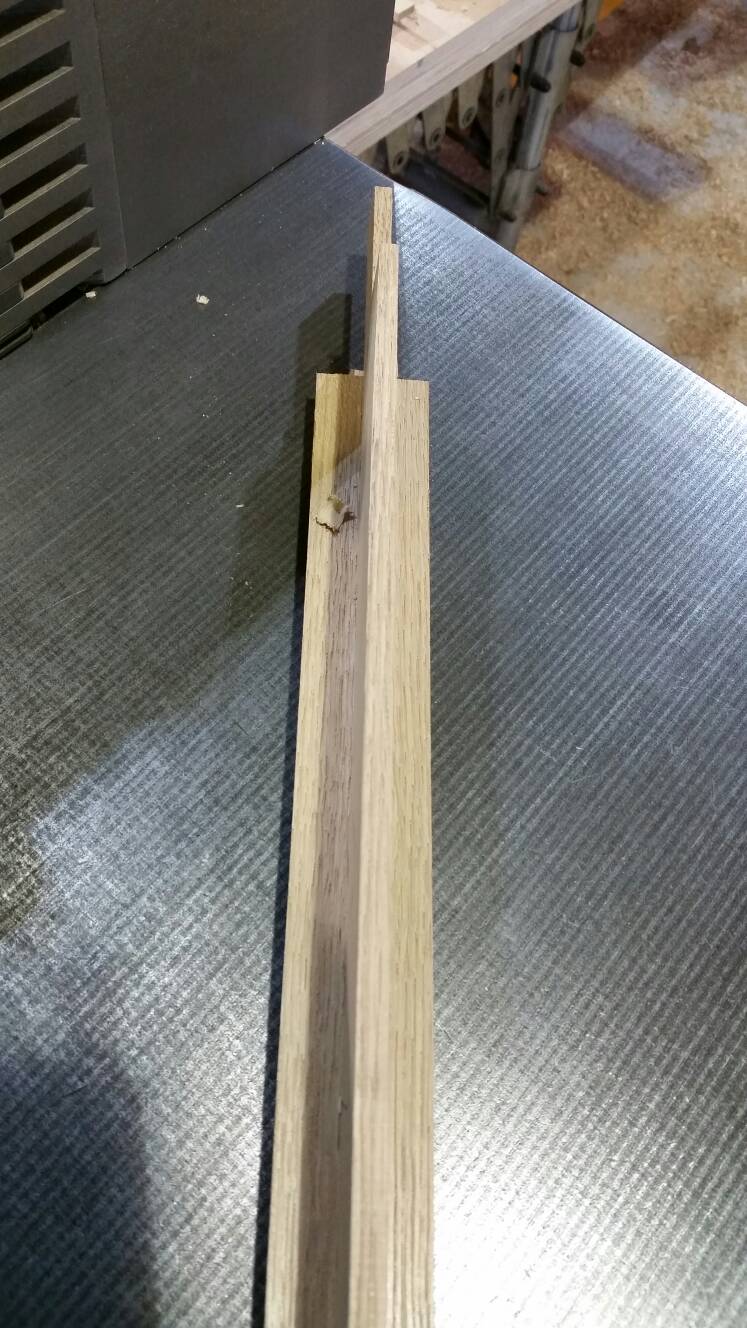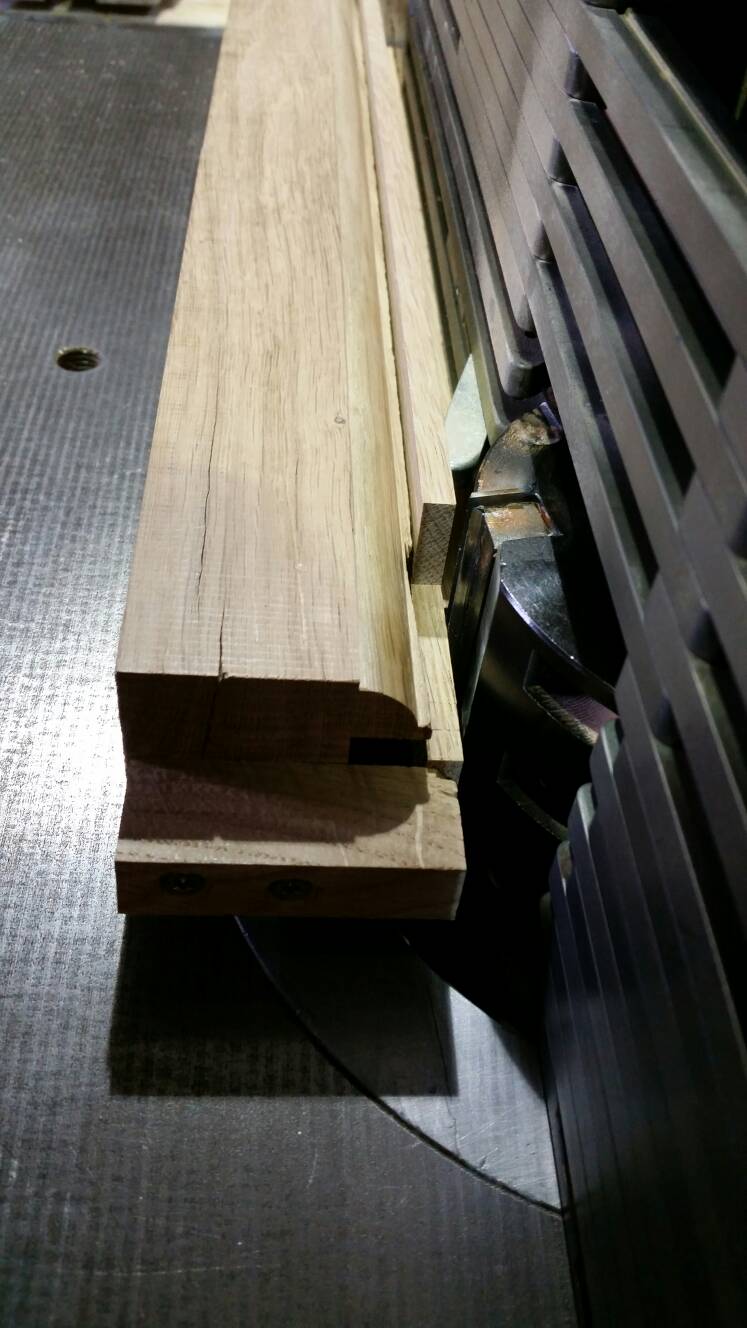You are using an out of date browser. It may not display this or other websites correctly.
You should upgrade or use an alternative browser.
You should upgrade or use an alternative browser.
Alternative To The Aigner Spindle Moulder Finger Fence?
- Thread starter pollys13
- Start date

Help Support UKworkshop.co.uk:
This site may earn a commission from merchant affiliate
links, including eBay, Amazon, and others.
I'd say you got a good deal there !!! I'd be tempted to ask Axminster if they'd consider selling perhaps 3 long fingers as an extra. It'd certainly tie the two fences together nicely and also support the workpiece completely right the way through. You may find the fingers are rigid enough that it doesn't cause any issues 
For the price I think you've got a cracking piece of kit !
Coley
For the price I think you've got a cracking piece of kit !
Coley
I had thought of having some fingers welded together to make up a long section? I'll ask Axminster if they can supply spare ones, might be less expensive to try to source the Chinese manufacturer on Alibaba.Would also have to factor in cost of welding and cleaning up the weld.ColeyS1":19fz0442 said:I'd say you got a good deal there !!! I'd be tempted to ask Axminster if they'd consider selling perhaps 3 long fingers as an extra. It'd certainly tie the two fences together nicely and also support the workpiece completely right the way through. You may find the fingers are rigid enough that it doesn't cause any issues
For the price I think you've got a cracking piece of kit !
Coley
On second thoughts will ask, for contact details of manufacturer, the fingers they must cut down to size. I contacted a Chinese manufacturer a while back, they make the Clarke mobile bases. I was after some extra long and short extension parts, so I could make the base large enough to fit on my tablesaw. His English wasn't so hot
As I say they must cut the fingers to size, I will ask Axminster.
My Draper 13766 400mm 3hp bandsaw came couple of days ago, 250mm depth of cut but enough for me, am very pleased with machine will do me.
custard
Established Member
I would't faff around trying to weld aluminium and hope it turned out straight. I'd get the straightest grained, quarter sawn board that I could find of a dense hardwood and make up some accurately profiled, long fingers out of that. You could use some tiny threaded inserts as securing fasteners. This would also have the advantage that you could make one for the bottom channel that had a shaped section in the centre which would mimic one of the big advantages of the Aigner.
That's a good shout regarding making hardwood fingers. - no fixing required, just slide a short finger in each end so it can't movecustard":18rtojj2 said:I would't faff around trying to weld aluminium and hope it turned out straight. I'd get the straightest grained, quarter sawn board that I could find of a dense hardwood and make up some accurately profiled, long fingers out of that. You could use some tiny threaded inserts as securing fasteners. This would also have the advantage that you could make one for the bottom channel that had a shaped section in the centre which would mimic one of the big advantages of the Aigner.
Coley
Hope you don't mind me showing another feature that made the aigner super easy and a nifty feature.

I was machining small glazing bars (only a 7mm flat) even using a spare bottom rail pushed against the side of the already profiled edge it still wibble wobbled on the end. The solution was to use the adjustable kicker

That stopped the very last bit from tilting in which made things much better.
I guess for yours you could just have a selection of commonly used rebate sizes and perhaps drill a hole in one of the fingers to screw from the back.
Yours would also be superb on a router table (with custards hardwood fingers)
Coley
Sent from my SM-G900F using Tapatalk

I was machining small glazing bars (only a 7mm flat) even using a spare bottom rail pushed against the side of the already profiled edge it still wibble wobbled on the end. The solution was to use the adjustable kicker

That stopped the very last bit from tilting in which made things much better.
I guess for yours you could just have a selection of commonly used rebate sizes and perhaps drill a hole in one of the fingers to screw from the back.
Yours would also be superb on a router table (with custards hardwood fingers)
Coley
Sent from my SM-G900F using Tapatalk
" This would also have the advantage that you could make one for the bottom channel that had a shaped section in the centre which would mimic one of the big advantages of the Aigner."custard":kz8o7dqd said:I would't faff around trying to weld aluminium and hope it turned out straight. I'd get the straightest grained, quarter sawn board that I could find of a dense hardwood and make up some accurately profiled, long fingers out of that. You could use some tiny threaded inserts as securing fasteners. This would also have the advantage that you could make one for the bottom channel that had a shaped section in the centre which would mimic one of the big advantages of the Aigner.
OK, see my new post on this.
I always, seem to get a better idea after the first one. I don't know why, duh? 
I have a friend who has a mill and a lathe, he makes scale model steam engines and stuff, he does little bits and bobs for me. I have some aluminium channel from B&Q for something else, that got the brain cells firing a bit. So I thought, what about the availability of suitable sized extruded aluminium?
Must be available in the same size,profile. I'm giving him the big nuts and bolts this Tuesday that held the bandsaw on the pallet. I'll ask him to measure up dimensions of the finger so I know size I'm looking for. If available will get some long lengths cut and ask him to thread a couple of holes in the end of each finger for the grub screws.
In meantime will send him pictures of the finger fence I posted here.
See attached photos of extruded aluminium.
I have a friend who has a mill and a lathe, he makes scale model steam engines and stuff, he does little bits and bobs for me. I have some aluminium channel from B&Q for something else, that got the brain cells firing a bit. So I thought, what about the availability of suitable sized extruded aluminium?
Must be available in the same size,profile. I'm giving him the big nuts and bolts this Tuesday that held the bandsaw on the pallet. I'll ask him to measure up dimensions of the finger so I know size I'm looking for. If available will get some long lengths cut and ask him to thread a couple of holes in the end of each finger for the grub screws.
In meantime will send him pictures of the finger fence I posted here.
See attached photos of extruded aluminium.
Attachments
RobinBHM":3ixb9orh said:If you use an 18mm false fence it may restrict the depth of cut because the shaft hits the back of the fence before the profile depth is reached. A common prkblem with fielding blocks.
To do that what comes to mind is using the mitre saw or tablesaw to remove the waste, would you do it like that or is there a better way?
Cheers.
Jacob
New Luddism. Awake and resist!
Chisel, knife, gouge, anything will do to chip off a bit of wood.
OK.Jacob":2pddnhxq said:Chisel, knife, gouge, anything will do to chip off a bit of wood.
I attach some new photos giving a more detailed view of an actual finger.Looking at them do you still think some hardwood finger could be made up? Adding rest of pictures to new reply, file size limitation.custard":1zber8oe said:I would't faff around trying to weld aluminium and hope it turned out straight. I'd get the straightest grained, quarter sawn board that I could find of a dense hardwood and make up some accurately profiled, long fingers out of that. You could use some tiny threaded inserts as securing fasteners. This would also have the advantage that you could make one for the bottom channel that had a shaped section in the centre which would mimic one of the big advantages of the Aigner.
Cheers.
Attachments
Jacob
New Luddism. Awake and resist!
I thought the off the shelf device was to save the bother of making a false fence from mdf etc. In which case making up the fingers would seem to defeat the object. Simpler to go back to the DIY false fence - and probably better in the long run as you can adapt the idea for various situations and be in control.
It's a five minute job to make a few fingers Jacob, that would give years of use. It'd take longer than that to cut out a wooden fence, find the screws, remove the standard fence, find a screwdriver, etc etc. Don't you think for the price it's pretty good ?
Coley
Coley
Jacob
New Luddism. Awake and resist!
You don't remove the standard fence you add the false fence to it with a few screws from behind. First time you might need to drill a few holes but not thereafter. Price - zero, it's usually a few bits from the offcuts bin.ColeyS1":qstloljf said:It's a five minute job to make a few fingers Jacob, that would give years of use. It'd take longer than that to cut out a wooden fence, find the screws, remove the standard fence, find a screwdriver, etc etc. Don't you think for the price it's pretty good ?
Coley
Similar threads
- Replies
- 5
- Views
- 8K



















